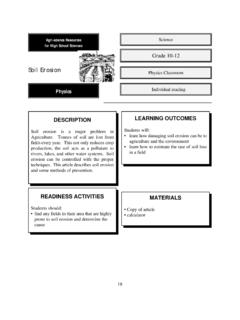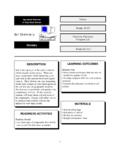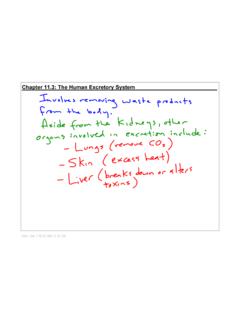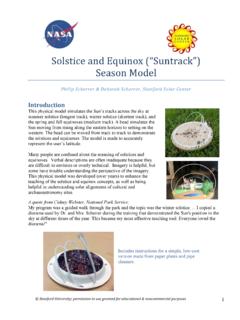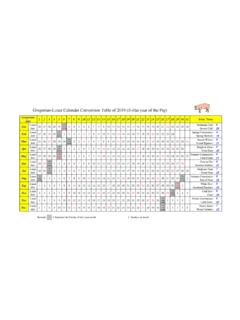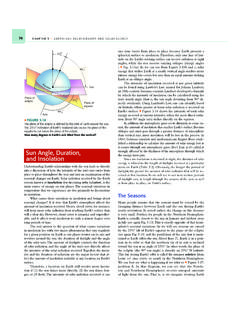Transcription of Chapter 3: Climates of the Earth
1 GeoJournal As you read this Chapter , note factors that affect climate. Then write a description of the Chapter Overview Visit the Glencoe World climate in your community. List three factors Geography Web site at that contribute to climate, and sketch a land- and click on Chapter Overviews Chapter 3 to scape showing one kind of common weather preview information about Earth 's Climates . in this climate. Guide to Reading Earth -Sun Consider What You Know News reports sometimes feature Relationships unusual events such as solar eclipses or solar flares, intense bursts of energy from the sun's surface. In what ways does the sun affect human activities? A Geographic View Read to Find Out Our Home Star How does Earth 's position in relation to the sun affect Through a small occulting telescope temperatures on Earth ? [equipped to block the sun's surface How does Earth 's rotation cause from view].
2 I stared at the dark- day and night? ened face of the sun, ringed by What is Earth 's position in relation its glowing, gauzy corona. From to the sun during each season? that blazing disk high in the How might global warming affect Hawaiian sky comes the endless Earth 's air, land, and water? power that drives and rules all life on Earth : its plant growth Terms to Know and the food chains of all its weather creatures; the winds, rains, climate and churning weather of the Sunset at the beach axis planet; the ocean currents, temperature forests, prairies, and deserts. revolution Samuel W. Matthews, Under the Sun: Is Our World Warming? . National Geographic, October 1990. equinox solstice greenhouse effect global warming From atop the Mauna Loa Observatory on the Places to Locate island of Hawaii, scientists gather data about changes in the Earth 's atmosphere. Their research reveals information about the dynamic rela- Tropic of Cancer tionships between the Earth and the sun, which influence all life on Earth .
3 Tropic of Capricorn In this section you will explore how Earth -sun relationships affect climate. Climate and Weather Climate is often confused with weather, which is a short-term aspect of climate. Weather is the condition of the atmosphere in one place during a limited period of time. When people look out the window or watch the news to see whether they need umbrellas or sunscreen, they are checking the weather. Climate is the term for the weather patterns Flamingoes enjoy an oasis at the that an area typically experiences over a long period of time. People foot of sand dunes in Namibia. who live in Seattle, Washington, for example, frequently use umbrellas Chapter 3 55. because of the rainy, wet climate. In contrast, people who live in the dry, desert climate of Arizona must protect themselves from the sun. Whether the climate in a particular region is cool and wet or hot and dry is determined by many factors, the most important of which is the Earth 's posi- tion in relation to the sun.
4 The sun's heat and light reach the Earth as warmth and sunlight, but they do not reach all parts of the Earth at the same time or with the same intensity. Arizona Lightning Earth 's Tilt Lightning and thunder are related weather events that result from the powerful air currents of thunderstorms during the warm- and Rotation weather months. Earth 's tilt is one reason for varia- Place What factor distinguishes weather from climate? tions in sunlight. The Earth 's axis an imaginary line running from the North Pole to the South Pole through the planet's cen- The Earth 's revolution and its tilt cause changes ter is currently tilted at an angle of about 23 1/2 . in the angle and amount of sunlight that reach dif- Because of the tilt of this axis, not all places on the ferent locations on the planet. These changes fol- planet receive the same amount of direct sunlight low a regular progression known as the seasons.
5 At the same time. During the course of a year, people on most parts For this reason the angle of tilt affects the of the Earth experience distinct differences in the temperature the measure of how hot or cold a length of days and the daily temperature as the place is. Areas that receive a large amount of direct seasons change. sunlight have warmer temperatures than places The seasons are reversed north and south of that receive little direct sunlight. Temperature is the Equator. When it is spring in the Northern Hemi- usually measured in degrees on a set scale. The sphere, it is fall in the Southern Hemisphere. When it most common scales for measuring air tempera- is winter in the Southern Hemisphere, it is summer ture are Fahrenheit ( F) and Celsius ( C). in the Northern Hemisphere. Around March 21, the Whether or not a particular place on Earth sun's rays fall directly on the Equator.
6 This day is receives light also depends on the side of the called an equinox (meaning equal night ) because planet that is facing the sun. Earth rotates on its daylight and nighttime hours are equal. In the axis, making one complete rotation every 24 hours. Northern Hemisphere, the day on which this Rotating from west to east, the Earth turns first one equinox falls marks the beginning of spring. hemisphere and then the other toward the sun, alternating between the light of day and the dark- The Tropics of Cancer ness of night. and Capricorn As the Earth continues its revolution around the Earth 's Revolution sun, it moves so that eventually the sun's rays While planet Earth is rotating on its axis, it also directly strike the latitude 23 1/2 N. This latitude is is traveling in an orbit around the sun, our nearest known as the Tropic of Cancer the northernmost star. It takes the Earth a few hours more than 365 point on the Earth to receive the direct rays of the days 1 year to complete one revolution, or trip sun.
7 These direct rays reach the Tropic of Cancer around the sun. about June 21, bringing the Northern Hemisphere 56 Unit 1. its longest day of sunlight. This date, known as the tinuous sunlight, while the other Pole is tilted away summer solstice, marks the beginning of summer from the sun and receives little to no sunlight. An in the Northern Hemisphere. Arctic explorer describes the surreal quality of the By about September 23, the Earth has moved so winter day: that the sun's rays directly strike the Equator again. This equinox marks the beginning of fall in the Northern Hemisphere. Gradually the sun's direct rays strike farther south, reaching their southernmost latitude 23 1/2 S, or the Tropic of Capricorn about December 22. The winter sol- The winter sun had completely disap- peared below the horizon, and the days'. were now only a few hours long.. I saw the Arctic in a whole new way, with its stice is the day of shortest daylight in the Northern Hemisphere, beginning the season of winter.
8 This cycle repeats itself each year as the Earth revolves around the sun. twilight days and auroral nights. Keith Nyitray, Alone Across the Arctic Crown, National Geographic, April 1993.. At the North Pole, the sun never sets from about The Poles March 20 to September 23. At the South Pole, con- The amount of sunlight at the Poles varies most tinuous daylight lasts from about September 23 to dramatically as the Earth 's revolution and tilt cause March 20. The tilt of the Earth 's axis as it revolves the changing seasons. For six months of the year, around the sun causes this natural phenomenon, one Pole is tilted toward the sun and receives con- known as the midnight sun. The occurrence of the DIAGRAM STUDY. The Seasons in the Northern Hemisphere SPRING WINTER. (March 21) (December 22). ays ect r Indir rays Direct Indirect rays Sun Indirect rays rays Direct ays ect r North Pole Indir Tro SUMMER p ic o fC.
9 (June 21) anc er Eq uat Tr or op ic of Cap rico r n FALL. (September 23). 1. Interpreting Diagrams Why are the seasons reversed South Pole in the Northern and Southern Hemispheres? 2. Applying Geography Skills Explain the difference between the equinoxes and the solstices. Chapter 3 57. midnight sun goes almost unnoticed in sparsely as water vapor and carbon dioxide (CO2) absorb populated Antarctica. Parts of northern North the heat reflected by the Earth and radiate it back America (including Alaska) and northern Europe again so that a balance is created. in the Arctic, however, have become popular Many scientists, however, claim that in recent tourist destinations as lands of the midnight sun. decades a rise in atmospheric CO2 levels has coin- cided with a general rise in global temperatures. This trend known as global warming is The Greenhouse Effect believed to be caused in part by human activities, Even on the sunniest days in the warmest cli- such as the burning of coal, oil, and natural gas.
10 As mates, only part of the sun's radiation passes more fossil fuels are burned, greenhouse gases through the Earth 's atmosphere. The atmosphere enter the atmosphere and trap more heat. reflects some radiation back into space. Enough Using computer models, some scientists predict radiation, however, reaches the Earth to warm the that global warming will make weather patterns air, land, and water. more extreme. Water, for example, will evaporate Because the atmosphere traps some heat and more rapidly from oceans, increasing humidity and keeps it from escaping back into space too quickly, rainfall generally. Rapid water evaporation from Earth 's atmosphere is like the glass in a green- soil, however, will cause land to dry out more house it traps the sun's warmth for growing quickly between rains. Some areas may even plants even in cold weather. Without this greenhouse become drier than before.
